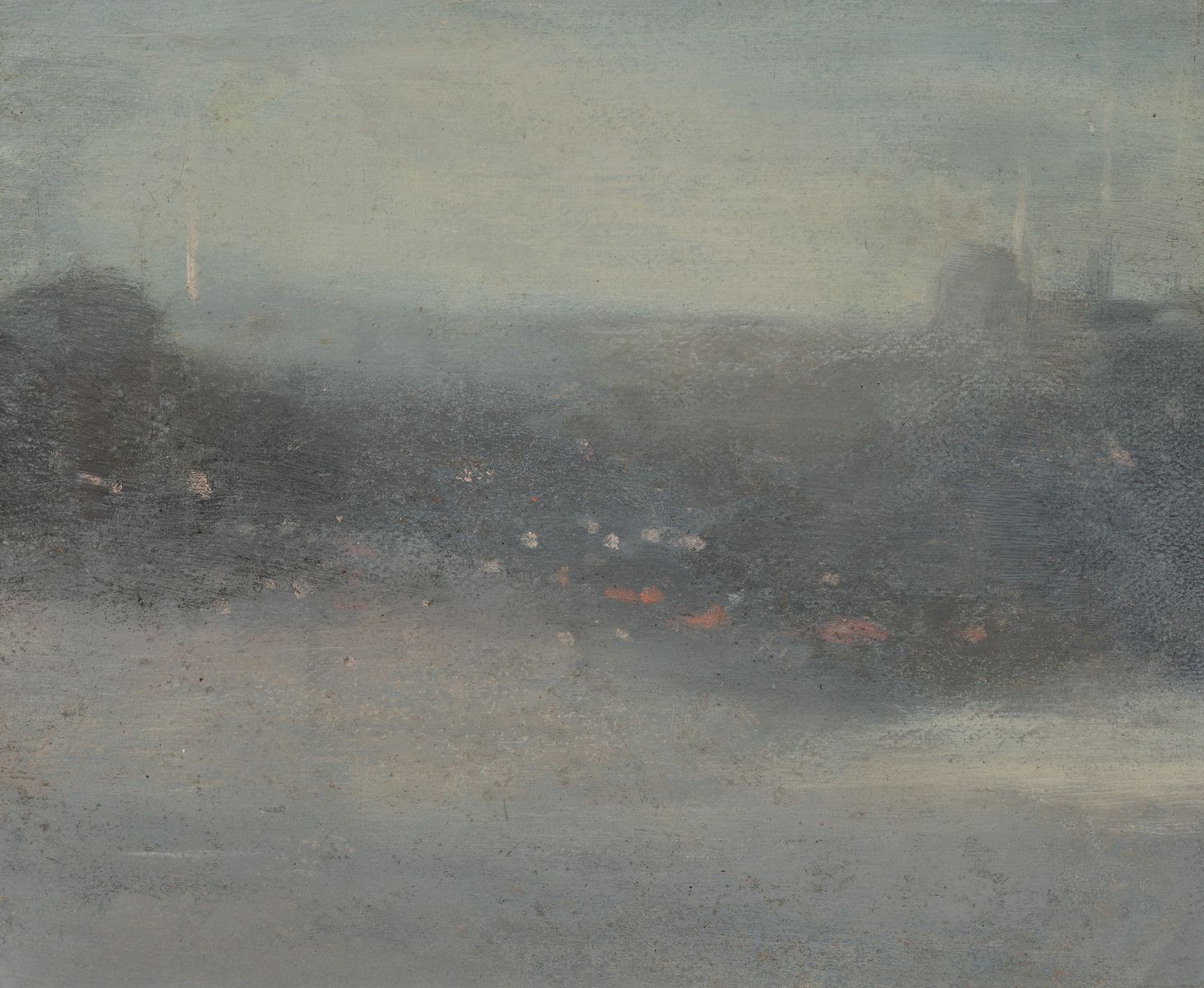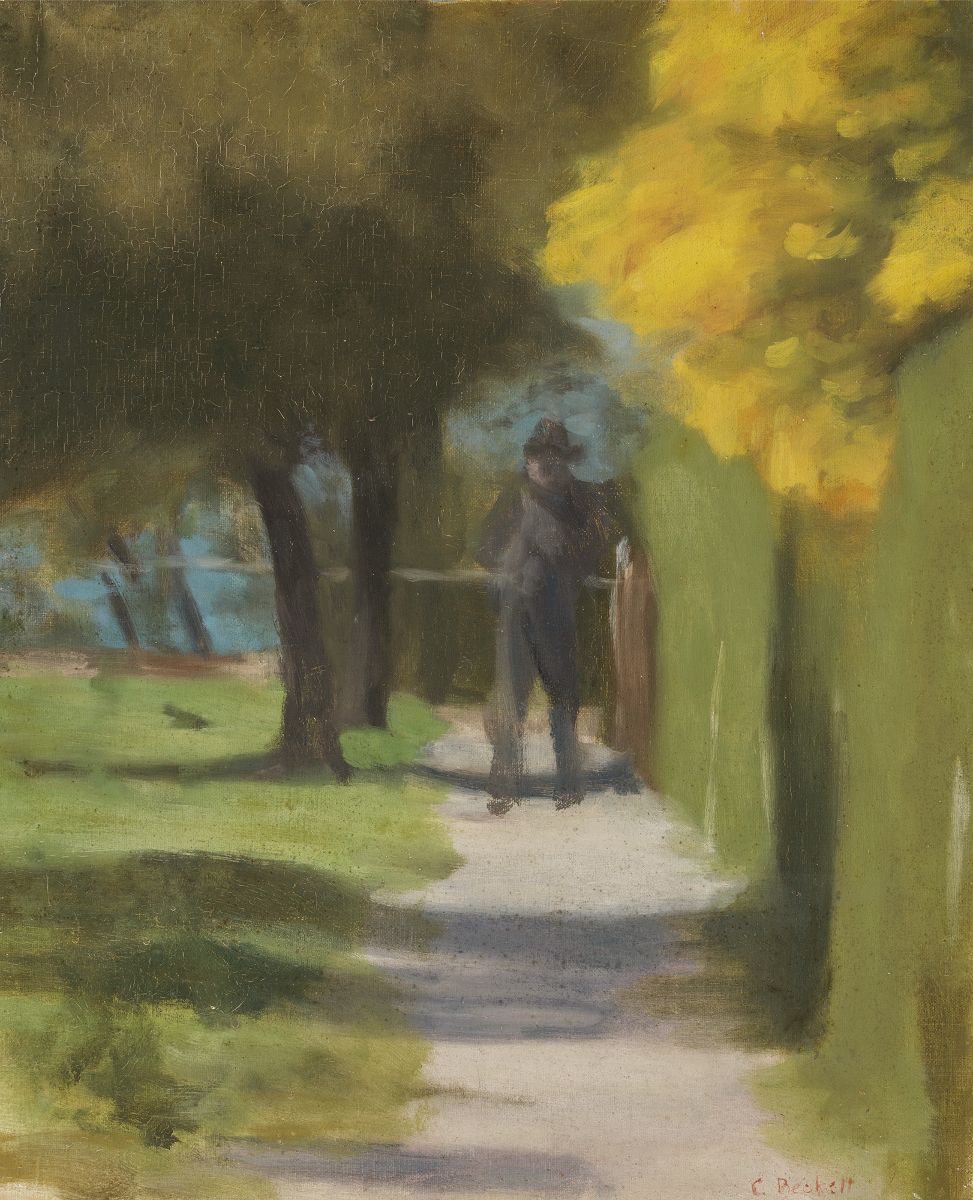
In a recent interview, art historian Rosalind Hollinrake recounts her search for Clarice Beckett’s grave. Although there was an empty plot next to those of Beckett’s parents, Beckett herself was not buried there. Instead, her grave was found two rows over, overgrown, nearly forgotten, with a bouquet of wilted flowers laid at the foot of her tombstone. An old gravedigger at the cemetery recalled a man in a hat and long coat who would deliver roses once a week until he, too, disappeared. When the flowers no longer appeared, Beckett’s grave, like her place in art history, became difficult to locate.
Shortly after Beckett’s death from pneumonia in 1935 at age 48, many of her paintings were burnt and destroyed by her father, with two thousand surviving paintings left in a shed in rural Victoria. It wasn’t until the 1970s that these works were rediscovered by Hollinrake, rotting in their abandonment, only about an eighth of them suitable for restoration. Through her research and dedication to sharing the work of this extraordinarily neglected artist, Hollinrake has done more than leave fresh flowers on her grave — Clarice Beckett has been returned to the light of Australian art history.

Clarice Beckett: The Present Moment, presented at the Art Gallery of South Australia, is the largest exhibition of the Australian tonalist painter’s work to date. A prolific painter, Beckett was an artist with a deep, almost preternatural understanding of capturing a moment of the day. She exhibited yearly from 1923 until 1933, and while her work was criticised and often overlooked during her lifetime, her paintings offer an intimate insight into the streets of 1930s Victoria.
Curated by Tracey Lock, this exhibition takes you from the first breath of dawn to the hush of sunset and finally into the enveloping mists of nightfall, guided by Beckett’s landscapes, portraits and still lifes. The Art Gallery of South Australia has gifted us with a very special body of work — paintings that feel very familiar in setting while remaining wrapped in the fog of a mysterious, enduring and dedicated artist.

Beckett’s paintings are calming — soft tonal works depicting beaches, quiet mornings, rain-kissed roads and soft-lit nights. There is a feeling of distance when looking at her paintings, as though you are observing from afar, gazing at a memory, or safely indoors, watching the rain fall. Her subjects are things often left unnoticed or unexamined, passing moments missed or not lingered upon for too long. She painted the essence of a scene, whatever it seemed to be: white light bouncing off the summer sand, a cloaking shadow over a Melbourne morning, two trams passing each other like ships in the night, a second of closeness before two ever-distancing paths.
Clarice Beckett often worked in en plein air, using a small painter’s cart, wandering the cliffs of Beaumaris. She spent much time at home, with no studio of her own, painting at her parents’ kitchen table in the moments she had between caring for her sick mother. She often worked at dusk and dawn, and it’s her paintings of these times that really highlight her ability to capture light and translate it onto canvas. Her sunsets and nocturnes showcase her impeccable talent for evoking mist, rain and fog; each of her works look glistening wet, depicting fleeting light. With small gestures in paint she creates poetic encounters — distant figures, flickering lights, glossy wet roads after a storm. Each painting feels like a dreamlike landscape, slightly out of reach.

Her ability to create a simultaneous intimacy and distance within each painting offers an insight into her world. Weather and surroundings are captured so gracefully that, despite the viewer being surrounded by dozens of paintings with recurring themes — traffic lights, sunsets, roads — there is no hint of repetition. Instead, Beckett invites us to catch a glimpse of a day when the world is sleeping.
The hang of this exhibition is ambitious; the large geometric archway doors that slice the rooms evoke a tone more akin to James Turrell’s skyspaces than Beckett’s gentle and hazed landscapes. Sunrise-to-sunset gradients span most of the rooms, with fuchsia tones at times attempting to compete with Beckett’s compelling sunsets. But the curation of this exhibition also guides us through a beautiful day. Paired with a soundscape by Simone Slattery, each room immerses the viewer in the glow of morning, to the rain soaked streets and misty nights by the sea.

It’s difficult to understand how Clarice Beckett’s presence in Australian art history hasn’t been more celebrated until recently. She was considered by some contemporaries to be an incredibly well-read, talented and diligent painter. After studying at the Melbourne National Gallery School under Freddrick McCubbin, she joined Max Meldrum at his newly established rival art school and continued to make soft tonalist works, that due to their soft palette and fog-like quality were considered radical and differed to bold landscape being created by her peers. Her work was exhibited in the First Contemporary All-Australian Art Exhibition at the Nicholas Roerich Museum in New York, and praised by New York Times critic Edward A. Jewell.
Beckett and her work have often been deeply admired, in a quiet way, although her commercial success was limited and the criticisms she received were harsh (“Fogbound art” and “a dull reiteration of nature”, according to contemporary critics in The Bulletin and The Sun). Perhaps her work was too radical for the time, her tonalist paintings too soft, too gentle, misaligned with the more ‘heroic’ landscapes that were being produced during Australia’s interwar period. Nevertheless, Australia is ready to see the world as Beckett did.

This exhibition is a gift, given to us by the dedicated women who refused to let the history of a very special Australian painter die. This dedication and endurance is worthy of Beckett herself — Rosalind Hollinrake and Tracey Lock have shone a light on an artist who gave us insights into subjects unnoticed and underappreciated. Through The Present Moment, Clarice Beckett’s talent and nuance reshapes how we view the everyday, reminding us there is beauty and mystery in simple, honest and ordinary moments.













